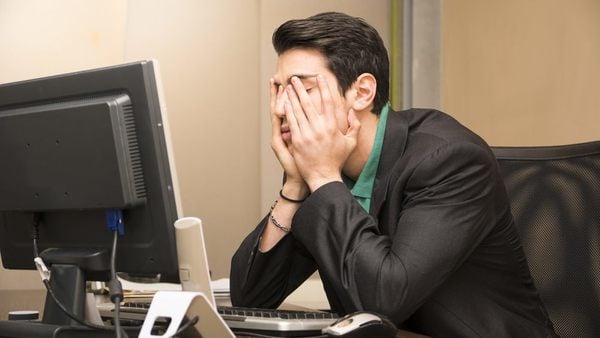 Long-term burnout can result in disruptions at work and prolonged physical and psychological challenges–issues that can't be swept under the rug or solved with an existing way of thinking. (Photo: Shutterstock)
Long-term burnout can result in disruptions at work and prolonged physical and psychological challenges–issues that can't be swept under the rug or solved with an existing way of thinking. (Photo: Shutterstock)
Fatigue has set in. We all know it. What some thought would last only a couple of weeks has lasted the better part of a year. The pandemic is taking its toll. People are struggling. Noted in a study published by Kennesaw State University, the harsh reality of "spillover" between work and home life is undeniable:
- Conflicts between work and family have magnified.
- Burnout is on the rise.
- Employers are struggling to find ways to manage their own stress and that of their employees.
- Employees, meanwhile, continue down a path of ill mental health.
There is a real need for proactive support — and a multitude of technologies requiring an employee to be always-on isn't the answer.
Recommended For You
"I'm not working from home, I'm living at work."
Job burnout is defined as "a special type of work-related stress — a state of physical or emotional exhaustion that also involves a sense of reduced accomplishment and loss of personal identity." The Kennesaw study found that burnout has significantly increased for workers during the pandemic.
The trend has been specifically acute for women and employees who did not have the flexibility to work from home before the pandemic began. Gallup research shows that as of September, nearly 40% of full-time employees were working entirely from home, versus 4% pre-COVID-19, meaning a significant percentage of employees are likely operating within a new environment. In addition, nearly 1 in 3 employees (29%) say they feel stressed either very often or always. Very often or always! That's a huge number of people working and living under a significant amount of stress.
But the pandemic will be over soon and everything will go back to normal, right? Not necessarily. Burnout, especially when experienced over a long period, can have serious long-term effects. A study by Plos One that was published in the National Library of Medicine identified these frequently investigated physical and psychological outcomes of burnout:
- Cardiovascular diseases
- Obesity
- Type 2 diabetes
- Metabolic syndrome
- Hypertension
- Insomnia
- Depression
All of these are serious conditions that can be either difficult or impossible to reverse. In addition to the outcomes of these potentially chronic conditions, Gallup has found that employees who experience high levels of burnout are:
- 63% more likely to take a sick day
- 13% less confident in their performance
- 23% more likely to visit the emergency room
In previous years, these numbers would be staggering enough. But now, with the increasing number of employees affected by long-term burnout, these numbers become even more problematic.
What does this mean in actual dollars and cents? Productivity losses from absenteeism cost U.S. employers $225.8 billion annually, or $1,685 per employee, according to the CDC. Additionally, employees suffering from depression cost U.S. companies $44 billion annually from lost productivity — $31 billion more than is lost by employees without depression.
String these supporting statistics together and what do you get? A significant percentage of individuals operating within a new, or altered, everyday work reality who are likely under a high amount of stress resulting in long-term burnout. This long-term burnout can result in disruptions at work and prolonged physical and psychological challenges. These aren't just current issues that can be swept under the rug or solved with an existing way of thinking.
An impressive tech stack doesn't equal a proactive solution
A new study by McKinsey has found that responses by employers to the COVID-19 pandemic has sped up by several years the adoption of digital technologies to meet new demands. Technology such as Slack, Jira, Zoom, and Miro are being evaluated and implemented at lightning speed to try and support employees. But is it enough?
With access to a multitude of digital tools and platforms, and the demands from home and work merging together, employees are in an "always-on" existence. It's an existence that these new technologies endorse and support. Demands from work and home aren't letting up, and the effort required to keep pace is getting heavier. The ability to turn off and unplug is diminished — and then burnout creeps in.
As if the pandemic itself weren't enough, employers are challenged with helping manage employees who are dealing with different triggers and levels of stress. Everyone's experience this year has been unique, which only adds to the complexity of deciding what tools and technologies are right for any company.
So where should leaders start?
Employers need a strategy that utilizes a whole-person, whole-organization approach to get ahead of the burnout crisis. Each individual's psychological, social, and physical well-being has to be considered when addressing mental health. If you have a system that assesses each of these spheres of an individual's wellbeing, you can deliver proactive support. Given the uptick in the number of employees currently either experiencing or at risk of burnout, traditional reactive strategies (e.g., the EAP) just won't work. By comparison, when you empower employees with actionable insights regarding their mental health, they are better equipped to deal with the stress and anxiety fueling burnout.
At the end of the day, each individual is on their own journey, and the pandemic has brought forth challenges that many of us have never had to face. Burnout can't be solved by only providing employees with the technology they need to literally get the job done in a remote environment. The answer is to provide employees with the support they need now to proactively manage their mental health.
Dr. Nick Taylor is CEO and co-founder of workplace mental health platform Unmind. Throughout his career, Dr. Taylor has always worked in mental health. During his time as a lead clinical psychologist in Britain's National Health Service, he realized the true importance of giving people the right care at the right time, and why the focus on mental health needs to be preventative.
Read more:
© 2025 ALM Global, LLC, All Rights Reserved. Request academic re-use from www.copyright.com. All other uses, submit a request to [email protected]. For more information visit Asset & Logo Licensing.







